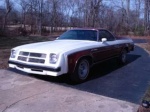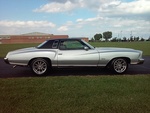Auxiliary transmission cooler orientation.
5 posters
G3GM :: G3 Tech :: Engine & Driveline
Page 1 of 1
 Auxiliary transmission cooler orientation.
Auxiliary transmission cooler orientation.
Just thought I'd post up my findings. Little background first.
I've installed tranny coolers on about 95% of all my owned vehicles. Daily drivers and all. I only purchase trucks with towing packages that consist of an extra tranny cooler and an engine oil cooler and at least a 3.42 gear otherwise I wouldnt touch it. So I dont have to install a tranny cooler on my trucks.
Anyway, I grabbed my father in laws 2004 impala with the great 3800 engine. He bought it new and I've maintained it its whole life. I've had several cars with this engine and have always gotten over 30 mpg highway and 25 city and sold them with over 250k on them and running strong.
So I have a B&M stacked plate tranny cooler I'm installing. I like the stacked plate design but I've installed lots of the normal fin type as well. All my installations have the fluid going through the rad first, then to the auxiliary cooler then back to the trans. I know factory installed coolers have their fittings facing downward and thats how I chose to install this one on the impala. Its been in about a week now and I decided to use my infra red temp gun and see how its doing. This cooler is about 12" long by about 8" high. I found that with the fittings facing down the difference between the inlet and outlet temp was an average of 24 degrees. Thats taking the reading, on the metal, right about the inlet and outlet tube entrance. But if I take a reading at the top of the cooler, on both sides, the temps are anywhere from 30-40 degrees cooler on both sides. So it had me thinking that maybe there is an air pocket up there that the fluid cant push out? I found that hard to believe but there is a substantial difference. I know the cooler is doing its job left to right (inlet to outlet) but definitely not up and down. My readings were taken after a 40 minute run on the highway so I know the engine and trans are at their full "heat soak" temps.
So I decided to flip the mount vertically. I dont mount my coolers through the fins of the condensor or rad. I use a strip of metal and secure to the top and bottom of the rad support. So I flip the cooler 90 degrees, fittings are now HORIZONTAL. Fluid entering the bottom fitting, just like in a stock rad, so the hot fluid spends time in the cooler as it travels to the top and exits back to the tranny. I take it out for a ride. Still about a 25 degree drop inlet to outlet which is good. But I now find that the inlet temp (bottom fitting) is the pretty much the same all across the bottom of the cooler. And the reading across the top of the cooler (exit fitting) is the same all the way across. So the cooler is working as it should but evenly across its entire area.
I went on net and started reading some threads where they discuss cooler orientation. The same two rules of thinking come into play. There's a bunch of guys who say the trans (or engine oil cooler for that matter) with the fittings facing downward, will push the air out of the cooler by the sheer volume of fluid entering the cooler. Then the other guys say they have to be horizontal or you will get an air pocket.
So, from now on, only from what I have found with the infra red temp gun, is that I will always be installing coolers with the fittings horizontally. Which actually makes for a slightly shorter connection hose length.
Just thought I'd post up as to my findings for you automatic guys. The manual trans is so much easier. LOL. Have a great day guys.
I've installed tranny coolers on about 95% of all my owned vehicles. Daily drivers and all. I only purchase trucks with towing packages that consist of an extra tranny cooler and an engine oil cooler and at least a 3.42 gear otherwise I wouldnt touch it. So I dont have to install a tranny cooler on my trucks.
Anyway, I grabbed my father in laws 2004 impala with the great 3800 engine. He bought it new and I've maintained it its whole life. I've had several cars with this engine and have always gotten over 30 mpg highway and 25 city and sold them with over 250k on them and running strong.
So I have a B&M stacked plate tranny cooler I'm installing. I like the stacked plate design but I've installed lots of the normal fin type as well. All my installations have the fluid going through the rad first, then to the auxiliary cooler then back to the trans. I know factory installed coolers have their fittings facing downward and thats how I chose to install this one on the impala. Its been in about a week now and I decided to use my infra red temp gun and see how its doing. This cooler is about 12" long by about 8" high. I found that with the fittings facing down the difference between the inlet and outlet temp was an average of 24 degrees. Thats taking the reading, on the metal, right about the inlet and outlet tube entrance. But if I take a reading at the top of the cooler, on both sides, the temps are anywhere from 30-40 degrees cooler on both sides. So it had me thinking that maybe there is an air pocket up there that the fluid cant push out? I found that hard to believe but there is a substantial difference. I know the cooler is doing its job left to right (inlet to outlet) but definitely not up and down. My readings were taken after a 40 minute run on the highway so I know the engine and trans are at their full "heat soak" temps.
So I decided to flip the mount vertically. I dont mount my coolers through the fins of the condensor or rad. I use a strip of metal and secure to the top and bottom of the rad support. So I flip the cooler 90 degrees, fittings are now HORIZONTAL. Fluid entering the bottom fitting, just like in a stock rad, so the hot fluid spends time in the cooler as it travels to the top and exits back to the tranny. I take it out for a ride. Still about a 25 degree drop inlet to outlet which is good. But I now find that the inlet temp (bottom fitting) is the pretty much the same all across the bottom of the cooler. And the reading across the top of the cooler (exit fitting) is the same all the way across. So the cooler is working as it should but evenly across its entire area.
I went on net and started reading some threads where they discuss cooler orientation. The same two rules of thinking come into play. There's a bunch of guys who say the trans (or engine oil cooler for that matter) with the fittings facing downward, will push the air out of the cooler by the sheer volume of fluid entering the cooler. Then the other guys say they have to be horizontal or you will get an air pocket.
So, from now on, only from what I have found with the infra red temp gun, is that I will always be installing coolers with the fittings horizontally. Which actually makes for a slightly shorter connection hose length.
Just thought I'd post up as to my findings for you automatic guys. The manual trans is so much easier. LOL. Have a great day guys.

Joe73- Donating Member

- Street Cred : 83
 Re: Auxiliary transmission cooler orientation.
Re: Auxiliary transmission cooler orientation.
Very helpful Joe. Thanks for the info and sharing.

fasrnur- G3GM Enthusiast

- Street Cred : 9
 Re: Auxiliary transmission cooler orientation.
Re: Auxiliary transmission cooler orientation.
Temperatures fluctuate all over the system.
Don't sweat it.
Everything is fine.
Don't sweat it.
Everything is fine.

Sinister- G3GM Member

- Street Cred : 0
 Re: Auxiliary transmission cooler orientation.
Re: Auxiliary transmission cooler orientation.
Nothing beats doing your own research.
One would think that an air bubble blocking access to some of the cooler would reduce its cooling effectiveness. But your readings seem to suggest that half a cooler works as well as a whole cooler. I guess GM might have discovered the same thing, and oriented it downwards just to make the plumbing easier or neater. Interesting work.
One would think that an air bubble blocking access to some of the cooler would reduce its cooling effectiveness. But your readings seem to suggest that half a cooler works as well as a whole cooler. I guess GM might have discovered the same thing, and oriented it downwards just to make the plumbing easier or neater. Interesting work.
crice63- Donating Member

- Street Cred : 2
 Re: Auxiliary transmission cooler orientation.
Re: Auxiliary transmission cooler orientation.
I had a 2002 Monte SS that I put 260k on before selling.
I installed a auxiliary trans cooler on early in its life. The "cop" edition Impalas came factory with one. I just followed GM's factory location for the W-body cars for guidance . Matter of fact...factory mount points were already present.
I installed a auxiliary trans cooler on early in its life. The "cop" edition Impalas came factory with one. I just followed GM's factory location for the W-body cars for guidance . Matter of fact...factory mount points were already present.

impalamonte- G3GM Enthusiast

- Street Cred : 18
G3GM :: G3 Tech :: Engine & Driveline
Page 1 of 1
Permissions in this forum:
You cannot reply to topics in this forum







» Roll Call and Car showcase
» Central Texas Noob
» Welcome Keith Seymore
» Wanted: Front park lamp assemblies
» 75 Hurst Olds T-tpos
» G3 Chevy rims- help ID these
» 75 el camino project.
» Have had a few questions
» vinyl top removal